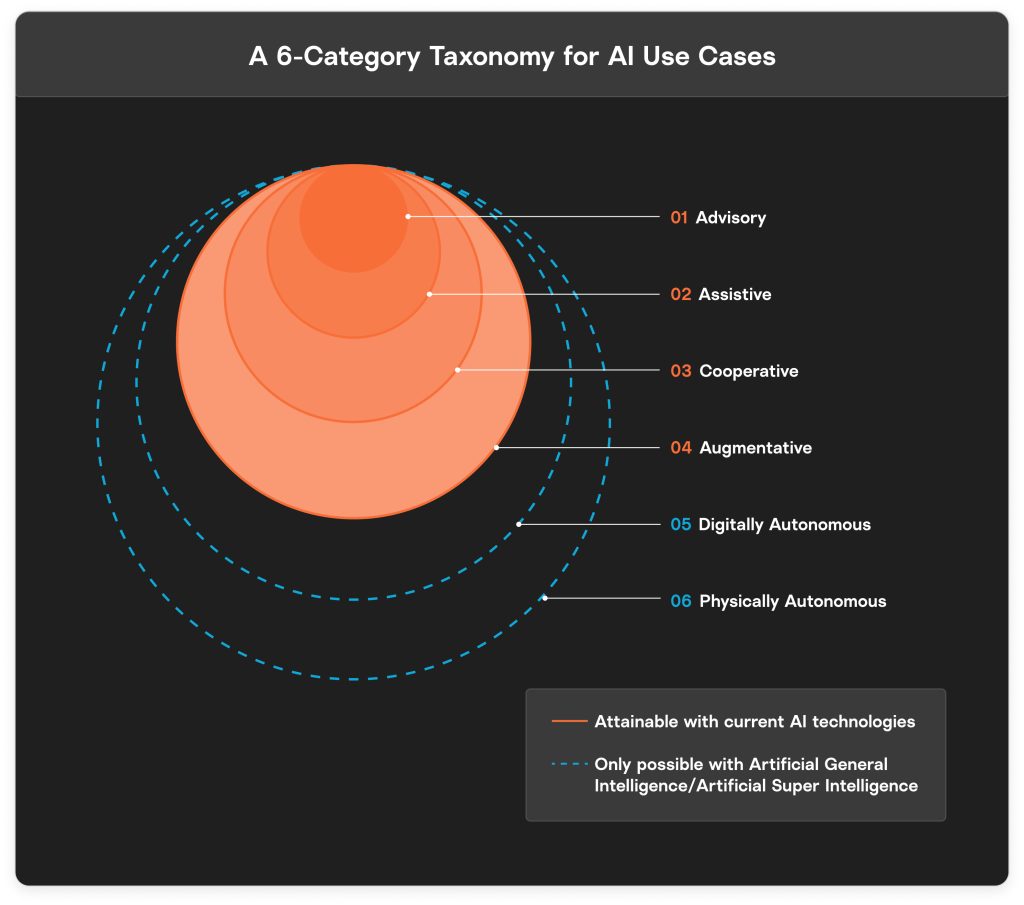Sinclair Schuller May 9, 2023
Getting started with a revolutionary technology like Generative AI (GenAI) can be overwhelming even to the most seasoned leaders. For large organizations in particular, the first challenge is identifying and developing use cases for AI-based products. We’ve found that the key to this critical exercise is establishing a common understanding and vocabulary that answers the question “What does one mean when they say XYZ?” about an AI implementation. In other words: a taxonomy.
Why is a taxonomy so valuable?
The taxonomy serves as a guide, accelerating the discovery of use cases by adding constraints. Constraints, in the context of product management and development, provide clarity, setting a “true north” for shaping feature development and go-to-market strategies.
By providing a structured framework, the taxonomy enables organizations to systematically explore and evaluate the applicability of GenAI by intersecting this taxonomy with knowledge they have in their specific domains, ultimately leading to more informed and strategic decisions.
A 6-Category Taxonomy for AI Use Cases
In our experiences with GenAI and product management, we’ve identified six taxonomic categories that most organizations can use to structure their analysis. This post will provide a high-level, coarsely defined taxonomy. This list is non-comprehensive (but has inspired me to carve out time to turn this into a whitepaper – stay tuned).
| Level | Description | Example(s) |
| 01 – Advisory | Provides domain-specific responses and guidance to user prompts, helping users navigate complex problems with expert insight. | 1. AI that, given access to a company’s financials, can provide fiscal/tax guidance. |
| 02 – Assistive | Offers implicit or explicit active task execution to assist users in achieving their outcomes, streamlining workflows and improving efficiency. A recursive, assistive AI would still qualify as Level 02. | 1. An AI that can book all aspects of business travel based on a calendar invite. |
| 03 – Cooperative | Involves a “back and forth” protocol where generative AI and the user work collaboratively towards a goal, and where the AI receives prompts “ambiently” by having extension tooling actively monitoring user behavior. This fosters a sense of partnership and shared responsibility. | 1. An AI platform that can accelerate cloud migrations. |
| 04 – Augmentative | Extends a user’s cognitive capabilities and skills into a different domain. This level implies that the AI bridges the user’s existing knowledge to accomplish things, at an expert level, at Levels 03 and below in domains they are completely unfamiliar with. | 1. AI that equips a UX designer to produce a functioning app from their design tool. |

| 05 – Digitally Autonomous | Manifested in digital form, capable of performing tasks and making decisions independently in digital environments, interacting with users and other systems through virtual environments, software applications, or digital platforms. These agents possess the ability to understand, learn, and apply knowledge across a wide range of tasks at a level comparable to, or even exceeding, human intelligence. An important criteria is that to be truly autonomous, a Level 05 needs to be able to (a) decide its own goals (bound by certain truths such as ‘do no harm’) and (b) be able to decide when to start and stop pursuing those goals. | 1. An AI agent that acts as an elite cybersecurity officer. 2. An AI agent that manages physical goods: inventory supply, demand, and logistics. |
| 06 – Physically Autonomous | Embedded in autonomous robotics, functioning independently in the physical world to perform tasks and make decisions, taking various forms such as industrial, medical, or humanoid robots, and working alongside humans or replacing certain human roles altogether. | 1. A humanoid AI capable of performing building construction. 2. Autonomous farming agent capable of making decisions and acting on when to turn the soil, plant crops, and harvest. |
This taxonomy can be visualized as concentric rings, with the innermost ring representing Level 01-Advisory. As we move outward, each subsequent ring corresponds to the next level in the taxonomy.

Some important ground rules with respect to this taxonomy are:
- Each level can do everything in the prior level. (Assuming Level 06 has connectivity, and, if it doesn’t, would operate in a “degraded” mode.)
- Each level becomes more generally intelligent (but not necessarily in terms of applied use) than the previous level.
- A given AI solution’s level isn’t exclusively tied to the underlying model’s capabilities. For example, a solution might qualify as Level 01, but bolting on an additional AI app might qualify the overall solution as Level 02.
Two interesting facets of this taxonomy are that (a) given today’s technology, Levels 01-04 are attainable and (b) given the proposed level of autonomy in Level 05+, it would likely only be possible through Artificial General Intelligence (AGI) or Artificial Super Intelligence (ASI). It’s important to acknowledge that, as of the time of writing this post, no-one has developed AGI+.
The Power of Cooperative AI
One of the powerful aspects of this taxonomy is the potential for AIs across these categories to cooperate and augment each other’s abilities. For example, a Level 01 AI might provide guidance to a Level 06 AI to optimize its decision-making in real-world tasks. Similarly, augmentative Generative AIs could enhance the capabilities of assistive Generative AIs by providing deeper insights and analytics, enabling users to derive greater value from their AI-driven tools.
This cooperative approach can lead to the development of more effective and sophisticated AI solutions, as the strengths of each category are leveraged to create a more cohesive and comprehensive system. By considering the potential synergies between different Generative AI categories, organizations can further refine their AI strategies and uncover new opportunities for innovation and growth.
Final Thoughts
As AI continues to reshape the business landscape, it’s vital to stay ahead of the curve and strategically position your organization for success in the AI era. Begin your journey by using the six categories of our Generative AI taxonomy as a springboard to evaluate the potential impact and opportunities within your organization. A clear taxonomic framework will empower your teams to better understand your organization’s use cases and map them to the appropriate taxonomic categories. This exercise not only helps identify the most promising areas for GenAI adoption, but also informs the overall organizational strategy in the context of AI.


